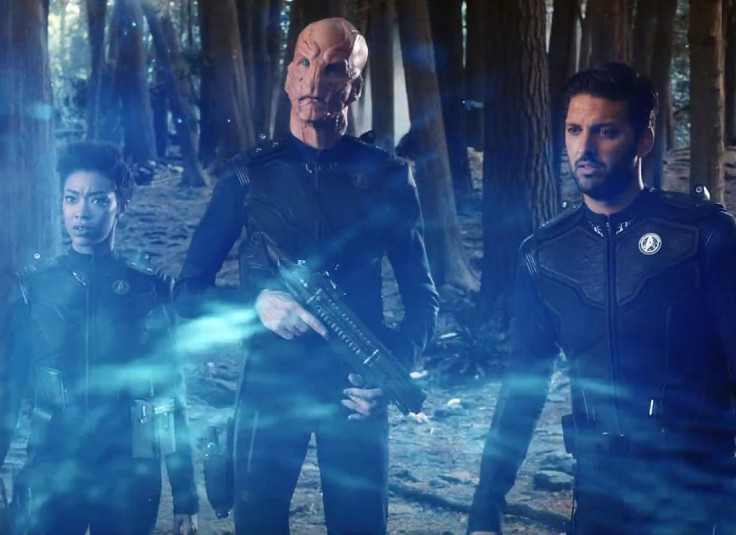After two solid episodes, each telling a non-serial, self-contained story, Star Trek: Discovery’s eighth episode, “Si Vis Pacem, Para Bellum” (“If you want peace, prepare for war”), returns to a completely unworkable combination of serial arcs and compressed, one-off storytelling.
It’s baffling how little plot the average Star Trek: Discovery episode manages. Whereas The Original Series or The Next Generation episodes frequently have enough breathing room for little character moments, a few turns in the plot, maybe an infodump or two, Discovery episodes consistently feel rushed and truncated, delivering the outline of a narrative in rapid-fire sequences squeezed between ongoing plot maintenance with the Klingons or, in this case, aboard the Discovery, where Lieutenant Stamets’ connection to the universe-spanning spore network is beginning to endanger his sanity.
In “Si Vis Pacem, Para Bellum” (competing with “The Butcher’s Knife Cares Blah For The Blerg Blarm” in the most pretentious title contest) Michael Burnham (Sonequa Martin-Green), First Officer Saru (Doug Jones) and Lieutenant Ash Tyler (Shazad Latif) visit Pahvo, a planet radiating a mysterious signal from a giant crystal spire. The plan is to modify Pahvo’s signal to serve as a galaxy-spanning sonar ping that Starfleet can use to triangulate the position of cloaked Klingon vessels. But when the Pahvans mind-meld with Saru, the Kelpien finds a peace he’s never experienced before, which he’ll do anything to preserve.
Of course, he takes it too far. After crushing their communicators, Saru does his best to convert Tyler to the planet’s harmonious hivemind. But it doesn’t really take, because, in one of the more confusing reveals of the episode, Saru isn’t being manipulated or controlled by the Pahvans. Nope, he just really likes being on Pahvo, apparently enough to fight Burnham to the death.
There’s really not much use for a subtle critique here — the Pahvans are dumb, Saru turning “evil” is dumb and the episode’s conflicts feel like notes rather than a fully fleshed-out plot. Discovery is riffing on TOS episode “Errand of Mercy” here, but it really only suffers in the comparison.
So… let’s bag it. The Pahvans can go back to their CGI goo matrix or whatever the hell their After Effects asses are made of. Instead, “Si Vis Pacem, Para Bellum” is maybe the best example yet of how Star Trek: Discovery’s serial storytelling consistently generates some of the most trite cliffhangers imaginable by smearing storylines over multiple episodes.
Check out Admiral Cornwell, who got her dumb ass captured by Klingons in “Lethe.” In this eighth episode she’s interrogated by L’Rell, one of T’Kuvma’s last remaining loyalists, who helped Voq escape a death sentence from Kol. L’Rell immediately begs to defect and Cornwell is happy to go along with her escape plan. When they’re caught in the act, L’Rell shoves Cornwell up against some sort of electric pylon, “killing” her.
Presumably, Cornwell isn’t actually dead and L’Rell is looking for her chance to slip away from Kol and escape with the Starfleet admiral. But we don’t actually know, because “Si Vis Pacem, Para Bellum” thought this would be better as a cliffhanger. Now we wait a week to learn the answer. Rather than leave us with a new revelation or the promise of an answer to a question burning us up inside, Discovery mainly uses its serial storytelling to withhold the obvious. And since we also have to check in on Stamets and the away team on Pahvo, Cornwell’s interrogation, escape and death are all collapsed into a handful of lines and moments. The stakes, characters and motivations suffer such severe truncation that it’s impossible to care about the outcome saved for the next episode.
The next episode of Star Trek: Discovery , “Into the Forest I Go,” will be the last in 2017, with the second half of Season 1 expected to premiere early next year.
- Richly redesigned Klingons
- Complex and explicable motives
- Great new Starfleet characters
- Incredible production design
- Generic space combat and action
- Too many flashbacks
- Eschews subtext, doesn't put enough faith in the audience



















